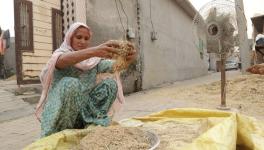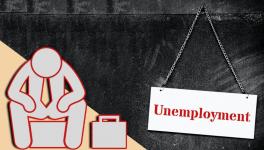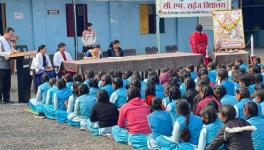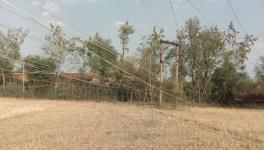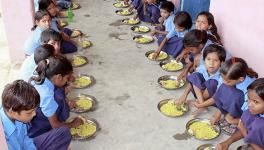Pitfalls of Government’s Big Push for Online Higher Education

Representational image. | Image Courtesy: UPETP.edu
The recent outbreak of the Covid-19 pandemic has forced academic institutions in the country to remain shut and it is highly uncertain when they will resume regular classes. Amidst this crisis, universities are grappling for ways to end semester on time and start the new academic session.
Online classes—through zoom and other apps and services—have emerged as the alternative in many public and private universities. Interestingly, most of them acknowledge the prevalence of digital divide, yet, surprisingly, look for online solutions in absence of other alternatives. Clearly, the depth of digital divide has escaped notice; for if a strategy is mostly exclusionary then it cannot be recommended as a solution.
However, as the lockdown entered its fourth phase, the government announced slew of measures for the higher-education sector. On 28 April, the University Grants Commission (UGC) submitted a report suggesting universities to complete 25% of the syllabus in online mode from the next semester. Taking this forward, on 17 May, the Finance Minister announced PM e-VIDYA programme permitting 100 top universities to “automatically” start online courses by 30 May. Further, the UGC has also asked colleges to start MOOC courses. However, shift to online mode has resulted in huge discontent among large sections of faculty and students. Is there any concrete reason for their disapproval?
Issues of access: rural-urban divide:
Due to the IT revolution in India one can easily understand the inclination for adopting online mode of communication; in fact, it seems to be an automatic choice for those seeking technocratic solutions to social problems. How balanced is this vision? For example, it’s revealing that India ranks at 127 among 201 countries in terms of internet penetration. What are the dimensions of penetration?
The most recent report released by National Sample Survey (NSS) 2017, which gathered information on access to internet, shockingly reveals that merely 23.8% of households have some kind of access. However, the situation is even more dismal when it comes to proportion of households owning computer or any form of device (viz. smartphones, tablets etc.)—only 10.7% households own any kind of device.
Now, perfect complementarity between internet connection and access to device is essential for effective participation in online mode. This is easy to understand—if, either the internet connection is unavailable while the device works offline or there is no disturbance in internet connectivity but the device stops working (possibly due to insufficient storage capacity especially in smartphones or power cut for hours—in either occasion, the participation in online mode gets impaired.
Thus, both uninterrupted internet connectivity and functioning/compatible device are essential for successfully joining online classes. Additionally, these facilities have to be present within the household simply because one cannot go out during the ongoing lockdown. In other words, switching to online classes in a lockdown assumes three requirements are fulfilled: (a) accessibility of device; (b) accessibility of working internet; and (c) both facilities are available within the household.
Further, effective accessibility to a device also depends on the number of devices present in the household and individuals competing for them. For example, there may be households where the number of individuals willing to attend online classes/activities is more than the number of devices available, in addition to limited data packs. Such complications raise doubts about the proposed solution.
From these figures, which apply to the country as a whole, let us turn to the higher-education segment. Unfortunately, the detailed NSS data pertaining to higher eduction for the survey year 2017 (along with consumption data) has been withheld by the government. Therefore, 2014 survey data is used in the rest of the analysis.
The transition to online platforms is often assumed to be a smooth process, particularly in the higher-education segment, for students pursuing higher education are often believed to come from the privileged section of society. Interestingly, data shows that even in households which have at least one member attending higher education, as many as 30% do not have access to internet and 56% do not have access to any kind of device (see figure 1). Further, and of great concern, is the finding that 55% of students pursuing higher education live in rural areas, where uninterrupted power supply is an additional problem. Figure 1 also depicts the sharp rural-urban divide: while 70% of rural households do not possess a device and 42% have no access to internet, the corresponding figures for urban areas are 40 and 15% respectively.
It is also useful to note that as per the NSS definition, households with access to internet do not necessarily mean that this facility is available within the boundaries of their residence—it includes access that may be available outside the household, such as in educational institutes, a cyber café or a neighbours’ residence, among other places. Therefore, effective internet access may be severely curbed at a time of practising physical distancing, in so far as access is not available inside the household.
Figure 1: Proportion of households (participating in higher education) with no access to computer/internet across locations
Class and caste divide
Not only does the foregoing discussion show the vacuity of online solution, a class analysis strikes at the very foundation of the purpose of higher education in society. If one of the important objectives of higher education is to bring about upward social mobility, figure 2 shows this idea to be unduly violated in the online mode.
Since inaccessibility of both internet connectivity and devices secularly decline with increase in income (proxied by expenditure), therefore, online participation steadily falls with declining income. For example, in the lowest (bottom 20%) income group, as many as 88% of households do not have access to device, but for the richest income group, it is 35%.
Figure 2: Proportion of households (participating in higher education) with no access to computer/internet across income groups.
Source: Calculated from NSS 71st round unit-level records.
Pervasive inequality is also visible along caste lines. Access to internet and devices is differentially distributed across castes. Figure 3 shows that whereas 48% of households from non-backward caste do not possess a device, and 23% do not have internet access. The corresponding figure for other backward classes is 59 and 31% respectively. And, for the ST community, the percentage of households without any device sharply jumps to 65% while 40% do not have internet access. For SCs, the corresponding figures are 69% and 40% who do not have a device and internet access, respectively.
Figure 3: Proportion of households (participating in higher education) with no access to computer/internet across caste groups.
Source: Calculated from NSS 71st round unit-level records.
Beyond these technical problems associated with inequitable access to online mode of teaching and communication, there are other grave shortcomings in the desire to shift to online classes. In a virtual classroom, the less vocal students run the risk of getting marginalised. Worse, absenteeism is blissfully ignored in online mode of interaction. Also, many students report feeling disconnected by the very limited scope for interpersonal interaction in the virtual space.
Further, social problems begin to emerge when one starts to dissect online communication. For example, availability of non-intrusive space within household is likely to be a luxury enjoyed only by a select few, especially in urban settings. Given our societal structure, women students may not be in position to devote uninterrupted time to online classes as they often have to perform household chores. Additionally, regular classes offer other important sources of learning such as opportunities for discussions with peers, which often take place outside class hours, other than time spent in libraries, doing fieldwork and so on.
Since online classes are patently exclusionary and seriously compromise the culture of debate and discussion, by switching to online mode one must be prepared to trade-off inclusivity and quality of education.
However, elite urban institutions have already adopted online teaching and, barring a very few exceptions, may not encounter the problem of exclusion. Although these institutions too complain about quality getting compromised, they may be set as examples of efficiency that others are to follow. But we have to be careful here, for during the lockdown the hidden privileges of urban elites simply manifest itself in form of comfortably switching to online classes—very similar to their quickly shifting to online payment portals during demonetisation to avoid standing in queues.
Thus the very special experiences of the urban elites with online classes cannot be generalised in a society which draws students from very diverse backgrounds, thanks to the rapid spread of higher education.
As the foregoing discussion shows, the adoption of online mode of teaching in higher education will exacerbate the already-uneven position of students. This, without obsessing over completing the semester on time, academic institutions must appreciate their diversity and stand in solidarity with their not-so-fortunate stakeholders.
We must recognise that this is a once-in-a-lifetime event and even as the pandemic continues to surprise us, the choice before academic institutions seems simple: either to rigidly follow deadlines or remain non-exclusionary. However, while reaching a decision the issues discussed here merit consideration.
Nivedita Sarkar teaches at Ambedkar University Delhi and Anuneeta Mitra is an independent researcher based in Chicago. The views are personal.
Get the latest reports & analysis with people's perspective on Protests, movements & deep analytical videos, discussions of the current affairs in your Telegram app. Subscribe to NewsClick's Telegram channel & get Real-Time updates on stories, as they get published on our website.










